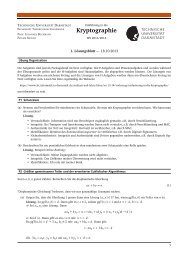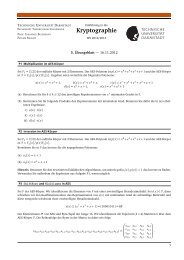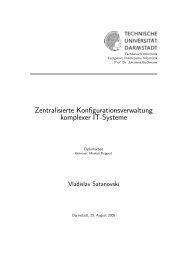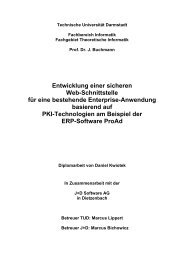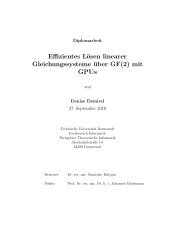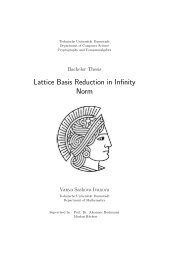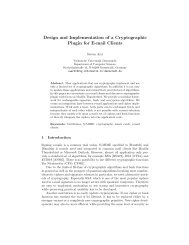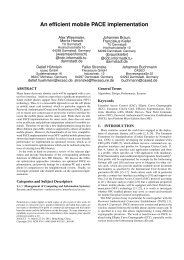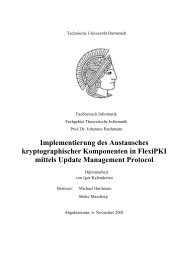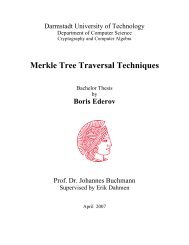Parallel Implementation of Classical Gram-Schmidt ...
Parallel Implementation of Classical Gram-Schmidt ...
Parallel Implementation of Classical Gram-Schmidt ...
Create successful ePaper yourself
Turn your PDF publications into a flip-book with our unique Google optimized e-Paper software.
<strong>Parallel</strong> <strong>Implementation</strong> <strong>of</strong> <strong>Classical</strong> <strong>Gram</strong>-<strong>Schmidt</strong><br />
Orthogonalization on CUDA Graphics Cards<br />
1 Introduction<br />
Benjamin Milde and Michael Schneider<br />
Technische Universität Darmstadt<br />
Department <strong>of</strong> Computer Science<br />
milde@stud.tu-darmstadt.de<br />
The <strong>Gram</strong>-<strong>Schmidt</strong> orthogonalization process is a fundamental algorithm in linear algebra [TB97].<br />
It is a method for orthogonalizing a set <strong>of</strong> vectors in the Euclidean space. It can be used to do a<br />
QR factorization [DGKS76] efficiently, that is a factorization <strong>of</strong> a matrix into an orthogonal and a<br />
triangular matrix. Two main computational variants exist, the classical <strong>Gram</strong>-<strong>Schmidt</strong> (CGS) and<br />
the modified <strong>Gram</strong>-<strong>Schmidt</strong> (MGS) [Lon81]. In practical applications MGS is <strong>of</strong>ten chosen, because<br />
it is numerically more stable than CGS. However, the latter algorithm is well suited for a parallel<br />
version [YTBS06]. Our results show that an efficient parallel implementation <strong>of</strong> CGS is also possible<br />
on current Graphics Cards.<br />
2 QR-Factorization with classical <strong>Gram</strong>-<strong>Schmidt</strong><br />
Let V be a square matrix <strong>of</strong> linear n × n vectors �v1, . . . , �vn ∈ R n , U a square matrix with �u1, . . . , �un ∈<br />
R n and µ ∈ R n×n a triangular matrix. The CGS algorithm, presented as Algorithm 1, uses V to<br />
compute U and µ so that V = U · µ and 〈 �uj, �uk〉 = 0 ∀1 ≤ j, k ≤ n; j �= k.<br />
Algorithm 1: Algorithm for QR-Factorization with classical <strong>Gram</strong>-<strong>Schmidt</strong><br />
Input: �v1, . . . , �vn ∈ R n×n<br />
1 µ ← In<br />
2 �u1 ← �v1<br />
3 for m := 2 to n do<br />
um � ← vm � − Pm−1 5<br />
i=1<br />
µm,i · �ui,<br />
where µm,i ← 〈 �u i, vm〉 �<br />
6<br />
〈 �u i, �u i〉<br />
7 end<br />
Output: ( �u1, . . . , �un) ∈ R n×n , matrix µ ∈ R n×n<br />
3 <strong>Parallel</strong> QR-Factorization with Classic <strong>Gram</strong>-<strong>Schmidt</strong> on Graphics<br />
Cards<br />
The algorithm can be parallelized in two ways. First <strong>of</strong> all, the inner product <strong>of</strong> two vectors is computed<br />
very frequently. According to the NVIDIA reduction paper [Har07], this can be best parallelized in a<br />
tree like manner using shared memory. A good starting point is to use n<br />
2 threads that compute the<br />
product in log(n) parallel steps. See the NVIDIA reduction paper [Har07] for further details. When<br />
computing sums with the parallel reduction algorithm in floating point, the accuracy rises compared
to the normal single algorithm. This is because on average more numbers <strong>of</strong> the same magnitude are<br />
summed up.<br />
The crucial idea for the parallel CGS is to transform it into a more suitable version (see Algorithm<br />
2). Instead <strong>of</strong> calculating every vector �u one after the other, one can subtract one term <strong>of</strong> the<br />
sum in Algorithm 1 line 5 for all vectors at once. This yields one new completed vector �u after one such<br />
step, that is needed for the next iteration. It also means that the degree <strong>of</strong> parallelization degrades<br />
after each step, with an average <strong>of</strong> n<br />
2 parallel operations at once. Global barrier synchronization must<br />
be used to guarantee that each new vector �u is available in the next iteration. Both methods combined<br />
allow a parallel version with a parallelization degree <strong>of</strong> approximately n2<br />
4 . This is sufficient to guarantee<br />
a good utilization on current graphics cards.<br />
Algorithm 2: Algorithm for parallel <strong>Gram</strong>-<strong>Schmidt</strong><br />
Input: �v1, . . . , �vn ∈ R n×n<br />
1 �ui ← �vi ∀i = 1 . . . n<br />
2 for m := 2 to n do<br />
invoke n − m + 1 blocks with 2 c 3<br />
threads<br />
4 for each thread do<br />
5 calculate <strong>of</strong>fsets for the vectors �u and �v according to block number and m<br />
sharedmemory[threadnumber] ← u[threadnumber] 2<br />
6<br />
7 synchronize all threads in a block (barrier synchronization)<br />
8 do sum reduction in shared memory<br />
9 usquare ← sharedmemory[0]<br />
10 sharedmemory[threadnumber] ← u[threadnumber] · v[threadnumber]<br />
11 synchronize all threads in a block<br />
12 if threadnumber = 0 then<br />
13<br />
sharedmemory[0] ← sharedmemory[0]/usquare<br />
14<br />
µ(<strong>of</strong>fset <strong>of</strong> �v, m) ← sharedmemory[0]<br />
15 end<br />
16 synchronize all threads in a block<br />
17 u[threadnumber] ← sharedmemory[0] · u[threadnumber]<br />
18 end<br />
19 end<br />
Output: ( �u1, . . . , �un) ∈ R n×n , matrix µ ∈ R n×n<br />
4 Results<br />
We implemented Algorithm 2 with CUDA in C. The algorithm given resembles very closely the structure<br />
and synchronization methods that must be used in CUDA. It should be noted that CUDA can<br />
only use barrier synchronization in a block, not for the whole card. In order to achieve a global synchronization,<br />
one must invoke a new set <strong>of</strong> blocks and threads each time, called kernel.<br />
Also one can see that in line 3 only 2 c threads, where c is some constant, can be invoked at a time.<br />
This is because <strong>of</strong> the tree like nature <strong>of</strong> the parallel sum reduction part. This restricts the dimension <strong>of</strong><br />
the input matrix to certain sizes. One can extend an arbitrary sized matrix to the next n that matches<br />
2 c and this can be relaxed further to c1 · 2 c2 by doing c1 multiplications for one shared memory entry.<br />
The implementation was tested on a workstation with a 3,0 GHz Intel CPU, and a Geforce 295. The<br />
Geforce 295 is actually two cards in one, each comparable to a Geforce 275 in terms <strong>of</strong> speed. Algorithm<br />
2 can only be applied to one card. A multi-card approach would produce a lot <strong>of</strong> communication between<br />
the cards, because the input matrix cannot be divided into independent parts. This would outweigh<br />
any speed benefits.<br />
2
For testing purposes we used random integer matrices with entry size up to 10 6 . We converted them<br />
to double precision floating points and measured the time it takes for the whole computation (including<br />
memory transfers for the Graphics Card). A speed-up <strong>of</strong> approximately 15x to an unoptimized single<br />
core reference implementation and a speed up <strong>of</strong> 3x to the <strong>Gram</strong>-<strong>Schmidt</strong> code in the library fpLLL<br />
[CPS] can be observed at dimension n = 2048. It should be noted that fpLLL only generates one<br />
output-matrix and does not save the values for µ, which are needed for a QR-factorization. That and<br />
the fact that it was only a reference implementation for comparing the results from the graphics card<br />
contribute to the problem that it is many times slower than the fpLLL code. Figure 1 and 2 present<br />
the results.<br />
time[s]<br />
time[s]<br />
60<br />
50<br />
40<br />
30<br />
20<br />
10<br />
<strong>Gram</strong>-<strong>Schmidt</strong> parallel CUDA (double)<br />
<strong>Gram</strong>-<strong>Schmidt</strong> fpLLL (double)<br />
<strong>Gram</strong>-<strong>Schmidt</strong> timings<br />
0<br />
0 500 1000 1500 2000 2500 3000 3500 4000 4500<br />
300<br />
250<br />
200<br />
150<br />
100<br />
50<br />
dimension<br />
Fig. 1. cuda<strong>Gram</strong>schmidt compared to fpLLL.<br />
<strong>Gram</strong>-<strong>Schmidt</strong> single C++ (double)<br />
<strong>Gram</strong>-<strong>Schmidt</strong> parallel CUDA (double)<br />
<strong>Gram</strong>-<strong>Schmidt</strong> fpLLL (double)<br />
<strong>Gram</strong>-<strong>Schmidt</strong> timings<br />
0<br />
0 500 1000 1500 2000 2500 3000 3500 4000 4500<br />
dimension<br />
Fig. 2. cuda<strong>Gram</strong>schmidt compared to fpLLL and the own reference implementation.<br />
Floating points are used to approximate the values in the output matrices. On all three implementations<br />
double precision (64-bit) was chosen. Current graphics cards are capable <strong>of</strong> calculating<br />
3
doubles natively, but at a slower speed than floats. On the other hand the precision <strong>of</strong> the standard<br />
float (32-bit) does not suffice for the big dimensions needed to exploit parallelism on the graphics card.<br />
Even on smaller dimensions (for example n = 128) 32-bit floating point is not enough to compensate<br />
the numerical problems <strong>of</strong> the <strong>Classical</strong> <strong>Gram</strong>-<strong>Schmidt</strong>. However, newer NVIDIA graphics cards will<br />
have a better double precision support. A big speed-up with our implementation on them, since it<br />
relies heavily on the double performance, will be noticed.<br />
References<br />
[CPS] David Cadé, Xavier Pujol, and Damien Stehlé. fpLLL - a floating point LLL implementation. Available<br />
at Damien Stehlé’s homepage at école normale supérieure de Lyon, http://perso.ens-lyon.<br />
fr/damien.stehle/english.html.<br />
[DGKS76] J. Daniel, W. B. Gragg, L. Kaufman, and G. W. Stewart. Reorthogonalization and stable algorithms<br />
for updating the <strong>Gram</strong>–<strong>Schmidt</strong> QR factorization. Mathematics <strong>of</strong> Computation, 30:772–795, 1976.<br />
[Har07] Mark Harris. Optimizing parallel reduction in CUDA, 2007. http://developer.download.nvidia.<br />
com/compute/cuda/1_1/Website/projects/reduction/doc/reduction.pdf.<br />
[Lon81] J. W. Longley. Modified <strong>Gram</strong>-<strong>Schmidt</strong> process vs. classical <strong>Gram</strong>-<strong>Schmidt</strong>. Comm. Statist. Simulation<br />
Comput., B10, 5:517–527, 1981.<br />
[TB97] Lloyd N. Trefethen and David Bau. Numerical linear algebra. Society for Industrial and Applied<br />
Mathematics, 1997.<br />
[YTBS06] Takuya Yokozawa, Daisuke Takahashi, Taisuke Boku, and Mitsuhisa Sato. Efficient parallel implementation<br />
<strong>of</strong> classical <strong>Gram</strong>-<strong>Schmidt</strong> orthogonalization using matrix multiplication. In <strong>Parallel</strong><br />
Matrix Algorithms and Applications — PMAA 2006, pages 37–38, 2006.<br />
4





